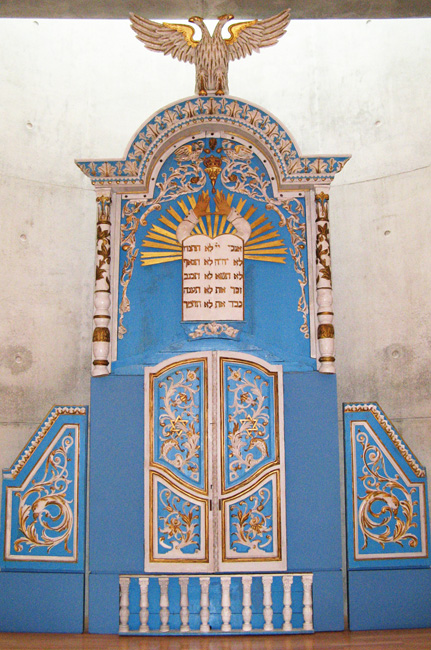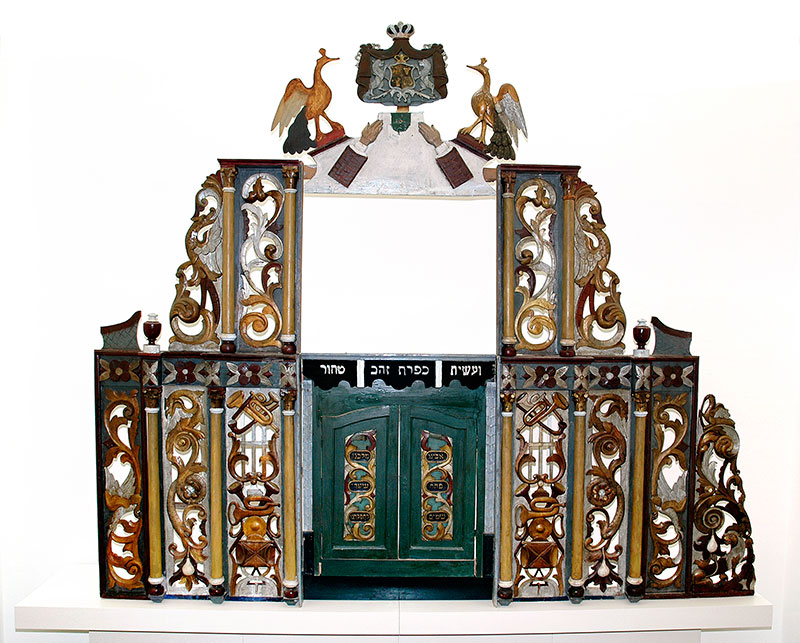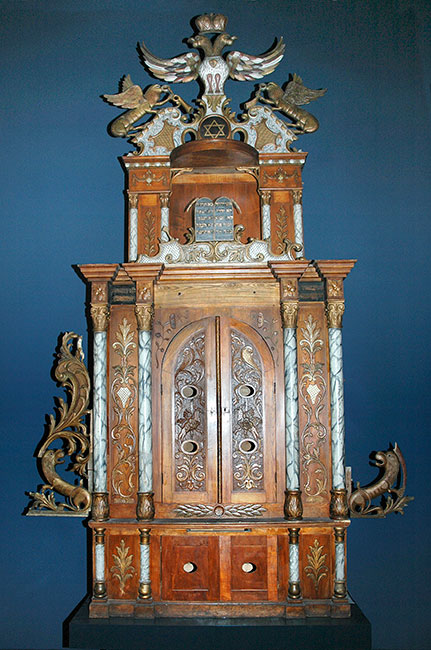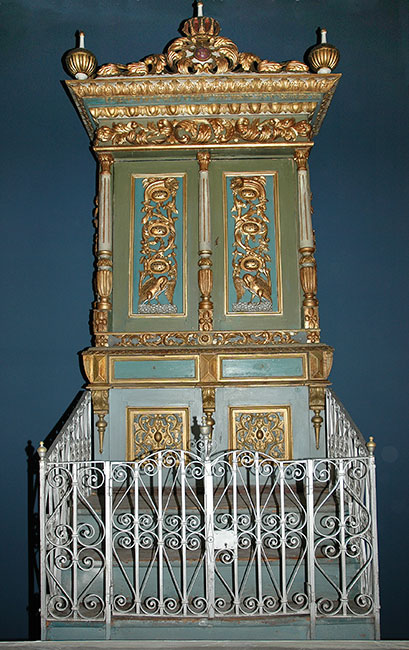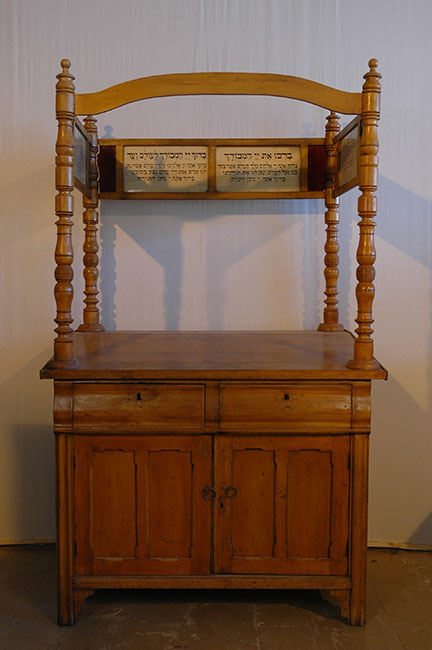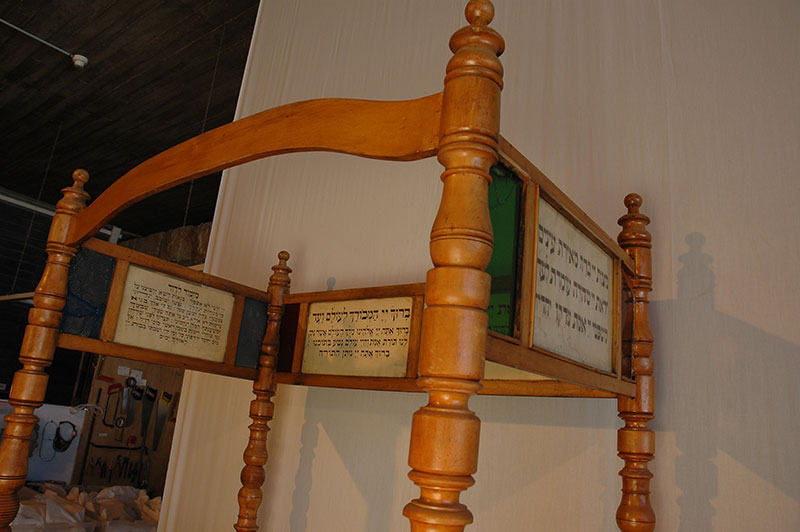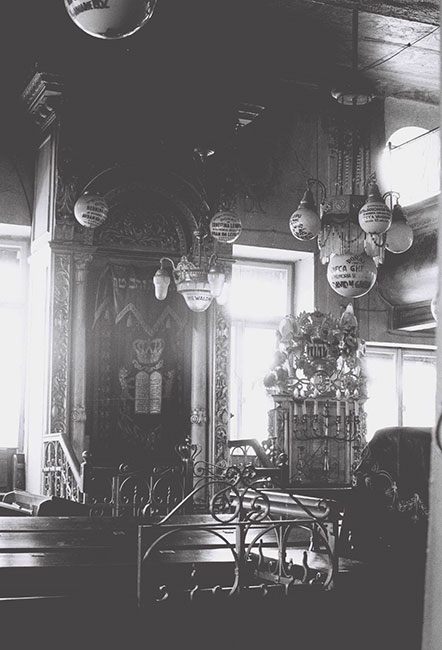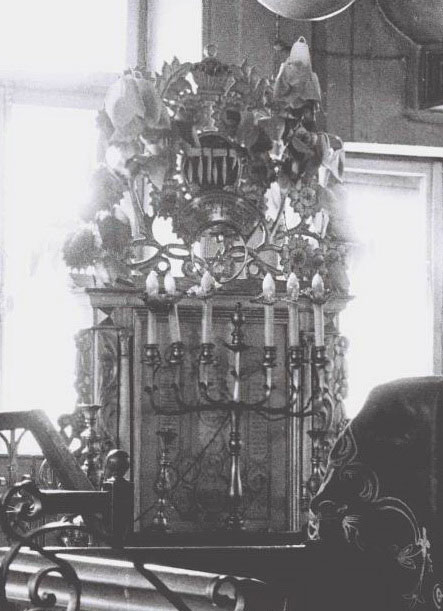The four Torah Arks displayed in the Synagogue at Yad Vashem are part of a collection of synagogue furnishings that were preserved and stored by the Jewish communities in Romania since the time of the war.
In a complex operation, with the assistance of Prof. Nicolae Cajal z”l, President of the Federation of Jewish Communities in Romania, and thanks to a special decision by the Government of Romania, the Torah Arks were brought to Yad Vashem. Once they arrived, they went through an intensive conservation process that included their reassembly and extensive restoration work.
Displayed in the Synagogue are the complete Torah Ark of the Apple Merchants’ Synagogue from Iaşi, Romania and three of four levels of the original Torah Ark from Rădăuti, Romania, as well as the façade of the Torah Ark from Hârlău, Romania that was pieced together from fragments.
The central element of the active area of the Synagogue is the Torah Ark whose façade is made up of fragments of the Torah Ark of a synagogue from Barlad, Romania.
Together, the display area and the active synagogue area present the lost splendor of Jewish life in the context of Jewish continuity.
Torah Ark façade (partial reconstruction using original pieces) Barlad, Romania circa 1870
Central to the Synagogue at Yad Vashem is a Torah Ark in which Torah scrolls, the most sacred items in the Synagogue, are housed.
The Torah Ark, symbolizing the Ark of the Covenant that stood in the Temple, has two doors that symbolize gates to the heavens. During the prayer service the "gates" are opened to take out the Torah scrolls. According to tradition, at this moment the gates of heaven open to receive the believers' prayers.
The Torah Ark was reconstructed from pieces of the "Tailor's Synagogue" in Barlad that were brought from Romania. The ark is painted sky-blue and adorned with gold and white carvings in a style popular in Moldavia and Ukraine in the 19th century.
The upper part of the Torah Ark is an elaborate arch set on two columns. Positioned below the arch are the Ten Commandments with rays of light behind them and hands spread for the priestly blessing set above. At the top of the Torah Ark is a two-headed eagle with wings spread and body tilted forward. The eagle is an allusion to God, who protects his people like an eagle protects its young.
After World War II, the Torah Ark was dismantled and parts of the façade were preserved until representatives of Yad Vashem located them and brought them to Israel. Lacking a photograph of the original Torah Ark, the curators of Yad Vashem's Artifacts Collection assembled the pieces to form the reconstructed façade of this Torah Ark, which is in active use today.
Yad Vashem artifacts collection
Donated by the Federation of Jewish Communities in Romania, Bucharest
The Tailors’ Synagogue, Hârlău, Romania
The façade of the Torah Ark of the Tailors’ Synagogue of Hârlău consists of a number of fragments that form two tiers of decoration depicting the theme of “musical instruments” set in foliage. The façade arrived at Yad Vashem in pieces and was reconstructed. The doors of the Ark are painted green and are inscribed with the passage “Our Father, Our King, open the gates of Heaven to our prayers”. Other details on the Torah Ark are hands with fingers spread in the fashion of the priestly blessing, a peacock, and a crowned shield. Recently discovered photographs of the synagogue interior from 1962 before the synagogue was closed, show the Torah Ark when it stood in all its glory.
At the end of the nineteenth and the beginning of the twentieth centuries, Hârlău had a vibrant and established Jewish community. Five synagogues served the community and served as a focus for assorted community activities. In 1910 over two hundred merchants and craftsmen were active in Hârlău, among them tailors, shoemakers, tinsmiths, carpenters and others. As the community flourished, anti-Semitic persecution intensified until nearly half of the community left the city, though the Jewish population remained at the same level because many of the Jews from surrounding villages moved to Hârlău.
During the Second World War, in the autumn of 1940, thousands of German soldiers were stationed in Hârlău and the mayor actively supported organized persecution of the Jews. This policy and repeated damage and theft of Jewish property caused many Jews to close their stores and flee, effectively bringing the economic life of the town to a standstill.
With the fall of the Iron Guard party in Romania, the leaders of the Jewish community managed to bribe the new mayor and the Chief of Police to agree to protect the Jews who returned to the town. This agreement saved most of the Jews of Hârlău until the town’s liberation by the Red Army in the spring of 1944. Today there are only twenty Jews in Hârlău and only the Great Synagogue remains.
Yad Vashem Artifacts Collection,
Donated by the Federation of Jewish Communities in Romania, Bucharest
Restored Torah Ark from a Synagogue in Rădăuti, Romania
The Torah Ark façade from Rădăuti came to Yad Vashem dismantled, in four main pieces: a base, two sections with doors and a section enclosing an arched space. Above these is a decorative panel consisting of a pair of griffins holding a Star of David between them. Above that stands a crowned two-headed eagle. On either side of one of the central sections are fragments of wing elements carved with lions emerging from foliage.
At the time of restoration work no archival photographs were available of the Torah Ark, so it was restored according to the judgment of the curatorial staff of the Artifacts Collection. When the Ark was included in the display of the new Synagogue in Yad Vashem, a decision was made to do without one section because of the limited height of the display area. Only recently was a photograph found that shows the Torah Ark before it was dismantled.
The Jewish community of Rădăuti swelled at the beginning of the nineteenth century under Austrian rule. At this time most of the Jews in Rădăuti were engaged in the lumber business or traded in livestock. By the end of the nineteenth century most branches of trade in Rădăuti were in Jewish hands, including the lumber and leather trades. A number of flourmills were in Jewish hands and Jews were also prominent in the professions. On the eve of the Second World War there were twenty-three synagogues and Hassidic prayer houses in Rădăuti.
Towards the end of the 1930s, persecution of the Jews in Rădăuti intensified and many were forced to flee. When large parts of Romania were annexed to the Soviet Union in 1940 the situation for the Jews deteriorated, and later when the Iron Guard came to power it worsened steadily, culminating in an organized pogrom that was carried out in the city in January 1941.
In June of the same year, upon the launching of “Operation Barbarossa” the final chapter of the Jewish community in Rădăuti began, with the setting up of a ghetto. Ten thousand Rădăuti Jews and many Jews from the surrounding communities were rounded up and deported to Transnistria in October. Only 1500 Jews returned to Rădăuti at the end of the war and after waves of emigration in the 1950s, only 800 Jews and 3 synagogues remained.
Yad Vashem Artifacts Collection
Donated by the Federation of Jewish Communities in Romania, Bucharest
Torah Ark from the Apple Merchants’ Synagogue, Iaşi, Romania
The Apple Merchants’ Synagogue (Merarilor Synagogue/ Merarskeshul), whose restored Torah Ark is displayed in the Yad Vashem Synagogue, is an example of a craftsmen’s association synagogue, of which there were many in Iaşi before the war.
Essentially a residential building, it became a synagogue in 1866 when it was purchased for a sum of 400 gold coins. Still standing at 17 Labyrinth St. (today 13 Elena Doama St.), the building is abandoned and in poor condition, remaining even today much as it was left after the pogrom of the 29th of June, 1941 when Romanian and German soldiers murdered some 10,000 Jews in Iaşi.
From the mid-sixteenth century until the mid-nineteenth century Iaşi was under Ottoman rule. In this period Jewish settlement developed rapidly with commercial and political ties developing between Jewish merchants and bankers of Constantinople (Istanbul) and the Jewish merchants of Iaşi. In fact, most of the craftsmen in Iaşi up to the beginning of the twentieth century were Jews who established their own associations, each founding its own synagogue. Ultimately, the prominence of the Jewish craftsmen in the economic life of the city contributed to perpetual friction and intensified the anti-Semitism that had been present since the establishment of Jewish settlement in Iaşi in the 16th century, culminating in the terrible events of the Holocaust.
Yad Vashem Artifacts Collection
Donated by the Federation of Jewish Communities in Romania, Bucharest
“The Ten Spheres” of Kabbalah – A Carved Decoration from a Prayer Lectern from the Zisu Herman Synagogue, Iaşi, Romania
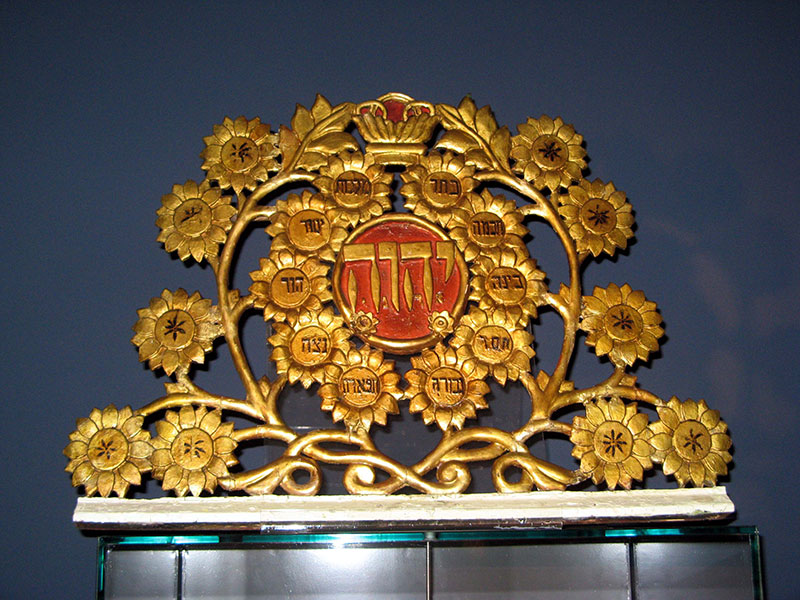
“The Ten Spheres” of Kabbalah – carved decoration of a prayer lectern from the Zisu Herman Synagogue, Iaşi Romania
Displayed in the Yad Vashem Synagogue is an elaborately carved fragment decorated with a depiction of the “Ten Spheres”of Kabbalah carved as flowers surrounding the name of God. After the fragment was displayed in Yad Vashem, photographs of the interior of a synagogue in Iaşi were discovered that enabled identification of the fragment as part of a decorated prayer lecternfrom the Zisu Herman Synagogue in Iaşi. The Torah Ark of this synagogue is also preserved at Yad Vashem.
The Zisu Herman Synagogue stood at 6 or 10 Labyrinth St. (today Otilia Cazimir – Zlataust St.) until 1979 when the area underwent reconstruction and the building was demolished. Synagogue furnishings were removed and stored by the Jewish community, and some of these are preserved at Yad Vashem.
Yad Vashem Artifacts Collection
Donated by the Federation of Jewish Communities in Romania, Bucharest




